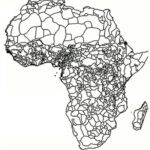One thing all elites of African countries have in common: they know their way to the airport. But what if that road is always hopelessly clogged with traffic jams? The Kenyan government found a solution by building an airway. This Nairobi Expressway does not have pedestrians and bicycles, donkeys and cows, handcarts and merchandise; you float over the asphalt without holes while enjoying panoramic views of the Kenyan capital.
“This is the best infrastructure project ever accomplished in Africa,” Kenyan transport minister James Macharia praised the Expressway at its opening in May. At 17 miles, the road is the longest in the air on the continent and perhaps the most expensive at 668 million US dollar. It is a toll road and is owned by the China Road and Bridge Corporation, which will hand it over to the Kenyan government in 27 years.
Passengers used to miss their flights because it took them sometimes three hours to cover a mere thirty kilometers. Now the visitor can drive from the airport to the business center of the city or the presidential palace in less than twenty minutes. “The road attracts foreign investors,” said Minister Macharia.
Zebra’s
The Expressway runs from the airport up the Uhuru Highway, which is the gateway to the capital and the backbone of Nairobi’s transportation system. When I arrived in Kenya half a century ago, zebras and gazelles grazed along that route to the city. Kenya then mostly had unpaved roads and only one two-lane road, the central Uhuru Highway, surrounded by pink bougainvillea, on which a few cars chugged, mostly owned by white or Indian or Arab, and rarely African drivers. The countryside was still alive in Nairobi, the greenery dominated the space, not the people and their cars. No one had heard of traffic jams yet.
Nairobi, like most African capitals, is a young city that was only founded around 1900. It was initially little more than a hamlet, with streets that turned into hip-deep mud channels in the rainy season. On the wide Sixth Avenue, now the central Kenyatta Avenue, the long bullock carts – often twelve to sixteen oxen were yoked – could turn. Now the skyscrapers of Kenyatta Avenue rise above the highway.
A little further on, rusty corrugated iron roofs at the train station can be seen. The construction in 1895 of the railway from Mombasa on the Indian Ocean to the interior heralded the beginning of the nation of Kenya. The headquarters of the railway was established where the capital was later created. Four mornings a week, at precisely 11:00 am, the steam locomotive from the coast puffed into Nairobi station. The black Kenyans had to travel on this 300-mile journey on a wooden bench in third class.
The prevailing pecking order – white, Arab, Indian and black at the bottom – also applied to Nairobi. The colonials turned it into an apartheid city. Any social contact between the different population groups was out of the question, residential areas were demarcated on the basis of ‘race’. The Kipande House is located near the station. It dates from 1913 and was for a long time the tallest building in the capital of the British colony. There every black person received his identity card, which he had to wear in a bronze pass holder around his neck like a cowbell with his name, tribal origin, boss and salary. If he was visiting the city for a short time, he had to renew his permit every three days.
Whites did not address blacks as ‘sir’ but as ‘boy’. These fourth-class citizens took shelter in so-called informal settlements, where they grouped around their government-appointed chieftains in tribal enclaves. Only in the red-light district of Majengo was there no apartheid, because prostitutes of all backgrounds worked there, including Asians and Europeans. Nairobi would always remain a city of migrants, few residents called it their “home”. The capital bore the scars of a ruthless division based on tribe and race.
A social division has replaced racial boundaries. Kenya belongs with Brazil to het countries in the world with the largest gap between rich and poor. Every inhabitant of Nairobi lives in his own social bubble, in pleasant residential areas or in raw ghettos, depending on his income.
The Expressway is a metaphor of that inequality. The criticism is that the government did not invest in an adequate transport system for everyone, but in an airway for the rich. The toll fares are high [one Expressway ride costs as much as four times a bus ticket into the city].
Car imports increased by 300 percent annually after the turn of the century, but most residents cannot afford a car. They walk. In a daily ritual just before dawn, rows of steamy job seekers walk with as much determination as red ants from the slums to the city center or industrial area. When they have work, they use the matatu, private vans that fulfill the role of public transport, but the matatus are not allowed on the Expressway. And underneath, the police chase homeless people away as soon as they put their piece of cardboard there to sleep, because it must not become a haven for the poor.
This article was first publised in the Netherlands newspaper NRC on 26-10-2022

